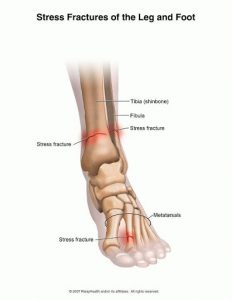
Are you a runner? Have you experienced unusual pain in your foot, knee, hip or even your lower back after taking a long run? Maybe you have noticed that this pain isn’t going away with rest anymore and the area is now getting warm and swollen.
Stress fracture – words that no runner wants to hear.
However, left untreated, this injury will most likely not get any better and in some cases can actually lead to a complete break of the affected bone. No one needs that in their life.
Don’t worry you’re not alone, these types of injuries are common in sports involving repetitive activities – like track and field, tennis and even basketball.
Generally, the most common sites of a stress fracture occur within the weight baring bones of your lower limbs. For the keen anatomists these sites can include:

Common sites of stress response and stress fracture in the lower leg.
A stress fracture can be the result of inadequate rest between your runs, or whatever repetitive sport you may be involved in. The muscles fatigue and reduce the support they provide to the joint and bones they help operate. This overloads the weight baring bones and doesn’t give them a chance to adapt and become stronger, instead they become brittle, weak and broken.
“But I rest between my runs”
Maybe your rest period loads don’t match your training load. Or, maybe your current exercise regime doesn’t include a resistance training program. This can be an important component in a runners training schedule as poor muscle strength and endurance can also contribute to the development of this condition. As well as increasing the strength of your muscles, resistance training is also handy for improving bone health too!
Running and repetitive injuries is something the physiotherapists of The Healthy Body Company deal with day in and day out. After a thorough and professional examination, your physiotherapist will make a clinical judgement regarding diagnosis of your stress fracture where you may be referred for medical imaging to identify the extent of injury.
Depending on the severity of the fracture your physio will then develop a rehabilitation program – this will be tailored to your specific case presentation and moulded to allow you to reach your physical goals to get you moving again. However, for the more extreme cases surgery may be warranted to elicit the best outcome to your injury. If this is indicated your physiotherapist will refer for an orthopaedic opinion and review.
If your running pain has you stressed out – come into one of our three practices (Caringbah, Jordan Springs and Penrith) for an assessment, diagnosis and treatment.
We’ll help put the kilometres back in your legs.
Matcuk GR Jr, Mahanty SR, Skalski MR, et al. Stress fractures: pathophysiology, clinical presentation, imaging features, and treatment options. Emerg Radiol 2016;23:365-75
McInnis KC, Ramey LN. High-Risk Stress Fractures: Diagnosis and Management. PM R. 2016;8:S113–S124.